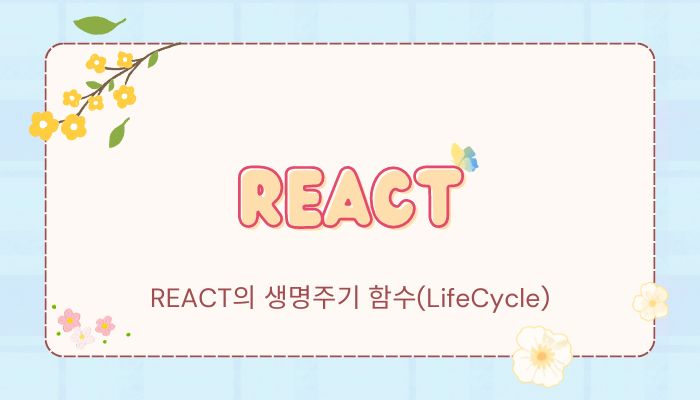리액트의 생명 주기 함수(LifeCycle)
REACT
해당 포스팅에서는 REACT의 생명 주기 함수(LifeCycle)에 대해 다룹니다.
이번 포스팅 목차
- REACT의 생명 주기 함수(LifeCycle)
리액트의 생명 주기 함수(LifeCycle)
생명 주기 함수(LifeCycle) 는 클래스형 컴포넌트에서 컴포넌트가 생성되고, 업데이트되며, 소멸되는 과정을 제어하기 위해 사용됩니다. 함수형 컴포넌트에서는 생명주기 함수 대신 훅(Hooks) 을 사용하여 동일한 작업을 수행할 수 있습니다. 여기서는 클래스형 컴포넌트의 생명주기 함수에 대해 자세히 설명하고, 함수형 컴포넌트에서의 훅 사용법도 간단하게 설명해보겠습니다.
클래스형 컴포넌트의 생명주기
클래스형 컴포넌트의 생명주기는 크게 세 가지 단계로 나눌 수 있습니다. 각 단계에는 여러 생명 주기 함수가 존재 합니다.
마운팅(Mounting): 컴포넌트가 생성되어 DOM에 삽입될 때 호출됩니다.
업데이트(Updating): 컴포넌트의 상태나 속성이 변경되어 다시 렌더링될 때 호출됩니다.
언마운팅(Unmounting): 컴포넌트가 DOM에서 제거될 때 호출됩니다.
1. 마운팅(Mounting)의 생명주기 함수
constructor(props)
컴포넌트가 처음 생성될 때 호출되며, 상태 초기화 및 클래스 필드를 바인딩하는 데 사용됩니다.
1
2
3
4
5
6
class MyComponent extends React.Component {
constructor(props) {
super(props);
this.state = { count: 0 };
}
}
componentDidMount()
컴포넌트가 처음 렌더링된 후에 호출됩니다. 여기서 AJAX 요청 이나 타이머 설정 등의 작업을 수행할 수 있습니다.
1
2
3
4
5
6
class MyComponent extends React.Component {
componentDidMount() {
console.log('Component has mounted');
// 데이터 가져오기 등의 작업
}
}
2. 업데이트(Updating)의 생명주기 함수
shouldComponentUpdate(nextProps, nextState)
컴포넌트가 리렌더링될지 여부를 결정합니다. 성능 최적화 를 위해 사용됩니다. 기본적으로는 true를 반환합니다.
1
2
3
4
5
class MyComponent extends React.Component {
shouldComponentUpdate(nextProps, nextState) {
return nextState.count !== this.state.count;
}
}
componentDidUpdate(prevProps, prevState, snapshot)
컴포넌트가 업데이트된 후에 호출됩니다. DOM을 조작하거나 네트워크 요청 을 할 수 있습니다.
1
2
3
4
5
6
7
class MyComponent extends React.Component {
componentDidUpdate(prevProps, prevState) {
if (prevState.count !== this.state.count) {
console.log('Component did update');
}
}
}
3. 언마운팅(Unmounting)의 생명주기 함수
componentWillUnmount()
컴포넌트가 DOM에서 제거되기 전에 호출됩니다. 타이머 정리, 구독 해제 등의 작업을 수행할 수 있습니다.
1
2
3
4
5
6
class MyComponent extends React.Component {
componentWillUnmount() {
console.log('Component will unmount');
// 정리 작업 수행
}
}
함수형 컴포넌트의 훅(Hooks)
함수형 컴포넌트에서는 이전에 다뤘었던 useState, useEffect 등의 훅을 사용하여 생명주기와 유사한 작업을 수행할 수 있습니다.
useEffect 훅
useEffect 는 컴포넌트가 렌더링될 때와 업데이트될 때 실행됩니다. 두 번째 인자로 전달되는 의존성 배열을 통해 특정 값이 변경될 때만 실행되도록 할 수 있습니다. 컴포넌트가 언마운트될 때는 정리 함수가 호출됩니다.
1
2
3
4
5
6
7
8
9
10
11
12
13
14
15
16
17
18
19
20
21
import React, { useState, useEffect } from 'react';
function MyComponent() {
const [count, setCount] = useState(0);
useEffect(() => {
console.log('Component did mount or update');
return () => {
console.log('Component will unmount');
// 정리 작업 수행
};
}, [count]); // count가 변경될 때마다 실행
return (
<div>
<p>You clicked {count} times</p>
<button onClick={() => setCount(count + 1)}>Click me</button>
</div>
);
}
마무리
리액트의 생명주기 함수 는 컴포넌트가 생성되고, 업데이트되며, 소멸되는 과정을 제어하기 위해 사용됩니다. 클래스형 컴포넌트에서는 다양한 생명주기 함수가 존재하며, 함수형 컴포넌트에서는 useEffect 와 같은 훅(Hooks) 을 사용하여 동일한 작업을 수행할 수 있습니다. 생명주기 함수를 올바르게 사용함으로써 컴포넌트의 상태와 동작을 효율적으로 관리할 수 있습니다. 마무리로 생명주기 함수를 요약해보겠습니다.
constructor(props): 상태 초기화 및 클래스 필드 바인딩
componentDidMount(): 컴포넌트가 마운트된 후 실행
shouldComponentUpdate(nextProps, nextState): 컴포넌트가 리렌더링될지 여부 결정
componentDidUpdate(prevProps, prevState, snapshot): 컴포넌트가 업데이트된 후 실행
componentWillUnmount(): 컴포넌트가 언마운트되기 전에 실행
오늘도 제 블로그에 방문해주셔서 감사합니다!
